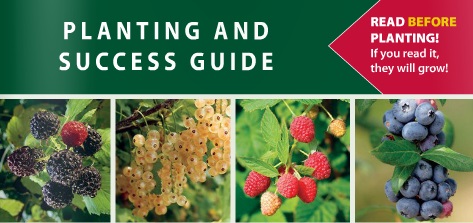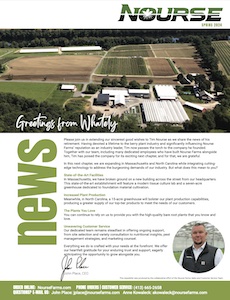How to Grow Asparagus
PLANTING
Choose a permanent location with well-drained soil, in full sun.
It is best if you prepare the site a year in advance. Remove all perennial weeds. Have a test done to be sure the soil is in the correct pH range and that it contains high levels of phosphorus. An application of lime may be needed to adjust the pH. If the phosphorus level is low, we recommend adding bone meal (½ lb. per 10-foot row) or super phosphate into the trench at planting. Spread phosphorus and lime thoroughly at the bottom of the eight to ten-inch deep planting furrow. Top-dressing with phosphorus lime is not effective.
For heavier, clay-like soils, six to eight inches deep furrows are recommended. Planting crowns too shallowly encourages early spear emergence, a higher probability of frost injury, and a greater probability of winter kill of crowns. In the early spring, at least two to three weeks prior to planting, incorporate five pounds of 10-10-10 per 100 square feet. If you have not fertilized two to three weeks before planting, side-dress four to six weeks later when the plants are growing well.
Lay roots along the bottom of the furrow and cover with two to three inches of soil. Roots are planted horizontally, parallel to the bottom of the trench and the soil surface, not vertically like strawberry plants.
As the spears grow up and expand into ferns, gradually fill up the trench with soil. You may mix up to 50% well-aged compost into the soil or add one pound 10-10-10 or equivalent balanced fertilizer into the soil as you fill in the trench. Within six weeks, the furrow should be completely filled. Using this method helps to limit weed development. You may wait until the ferns are growing above the trench and fill the trench at one time.
Spacing
- Twelve to fourteen inches between plants unless otherwise specified.
- Six to eight inches between plants is recommended for Purple Passion.
- Three feet between rows.
- Furrows should be eight to ten inches deep for most soils.
- Furrows of eight inches are recommended for heavier clay-like soils.
IRRIGATION
Plants need a well-drained site. Maintaining moisture during the establishment period is very important. Lighter soils may require more frequent watering than heavier soils, which retain moisture better.
FERTILIZATION
Establishment Year
Do not add compost or fertilizer until plants are growing. After plants have started to grow, fertilize during the period the trench is being filled. You may mix up to 50% well-aged compost into the soil or add one pound of 10-10-10 or equivalent balanced fertilizer into the soil as you fill the trench. Side-dress in early August with one pound of 10-10-10 fertilizer per 100 square feet (or equivalent) and lightly work into the top two inches of soil.
Succeeding Years
Use two pounds 10-10-10 per 100 square feet in early spring and again following harvest. To maintain optimum soil condition, test your soil pH every three to four years and amend as necessary. Broadcast lime, bone meal, and superphosphate according to soil test results and recommendations, keeping the pH 7.2 or higher.
WEED CONTROL/MULCHING
During the harvest period, manually pull weeds so emerging spears are not injured. Ferns will die back naturally in the fall. Mulch the dried ferns with a mower in the spring to reduce weed pressure. Check with the local extension before using chemical products. If tilling the soil during the rest of the growing season, only till ½–1 inch of the soil surface. Deep tilling can damage your crowns and bring weed seeds up to the surface.
HARVESTING SPEARS
Research shows that you can begin to harvest asparagus the year after establishment. Cut or snap all five to eight-inch spears that appear for a period of seven to ten days. Make sure you cut or snap stalks close to the soil surface, not leaving stubs. When spears begin to get spindly, stop harvesting for the season and allow all new spears to develop into ferns. To feed the crown. In the second season, you can harvest all the new spears that appear for a period of three to four weeks. By the third year, you can harvest for the full season, which is usually six to eight weeks long.
ASPARAGUS PLANT QUICK REFERENCE
Spacing
- Twelve to fourteen inches between plants unless otherwise specified
- Six to eight inches between plants is recommended for Purple Passion
- Three feet between rows
- Furrows should be eight to ten inches deep for most soils
- Furrows of eight inches are recommended for heavier clay-like soils
Irrigation
- Plants need a well-drained site
- Lighter soils may require more frequent watering
- Important to maintain moisture during the establishment year
Fertilization
- Before planting add five pounds of 10–10–10 per 100 square feet
- In establishment year dress in August with one pound of 10–10–10 per 100 square feet and work into the top two inches of soil
- In following years use two pounds 10–10–10 per 100 square feet in early spring and again following harvest
- Lime, bone meal, and superphosphate help maintain proper soil levels
- pH: 7.0–7.2—this is very important
Weed Control
- Ferns will die back naturally in the fall
- Mulching dried ferns with a mower in the fall will reduce weed pressure
- Contact a local extension for chemical recommendations



